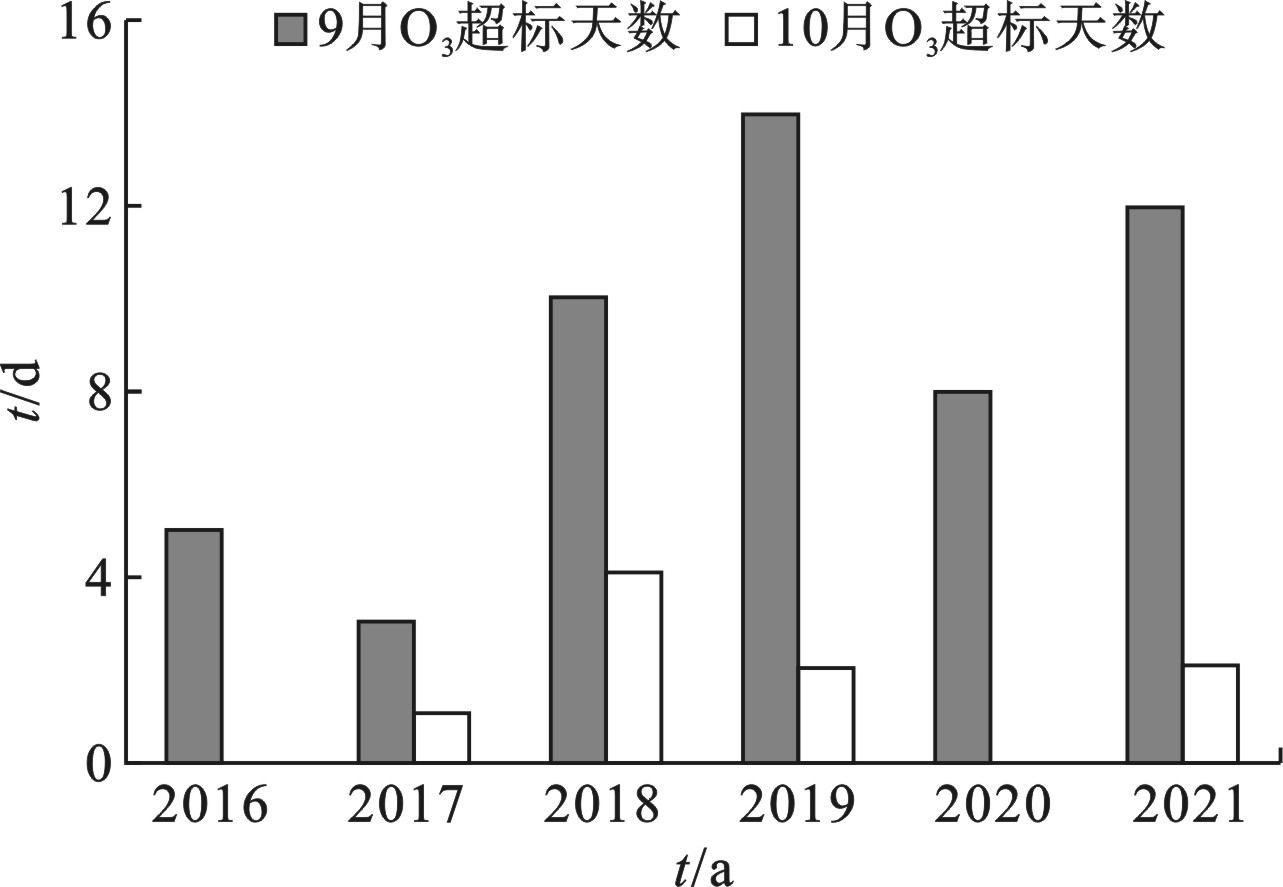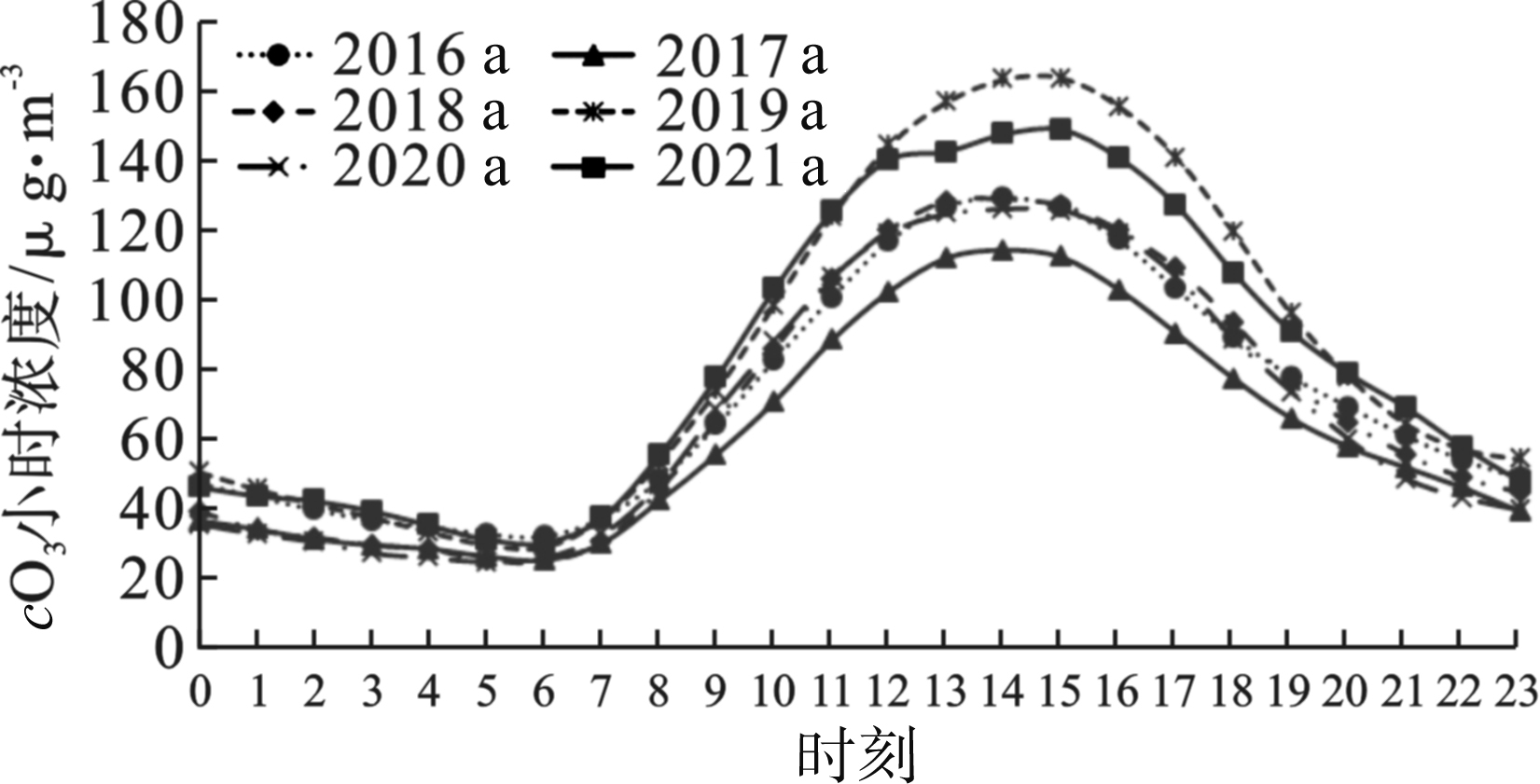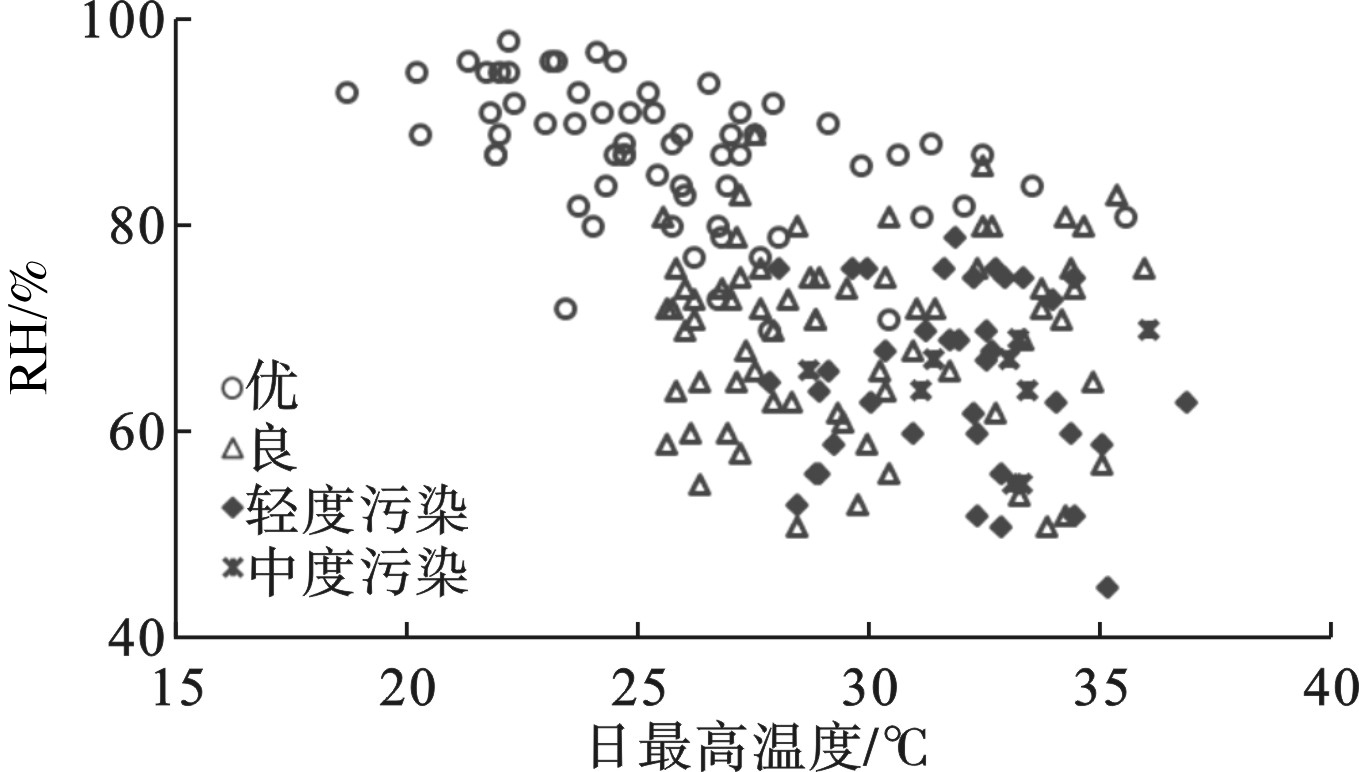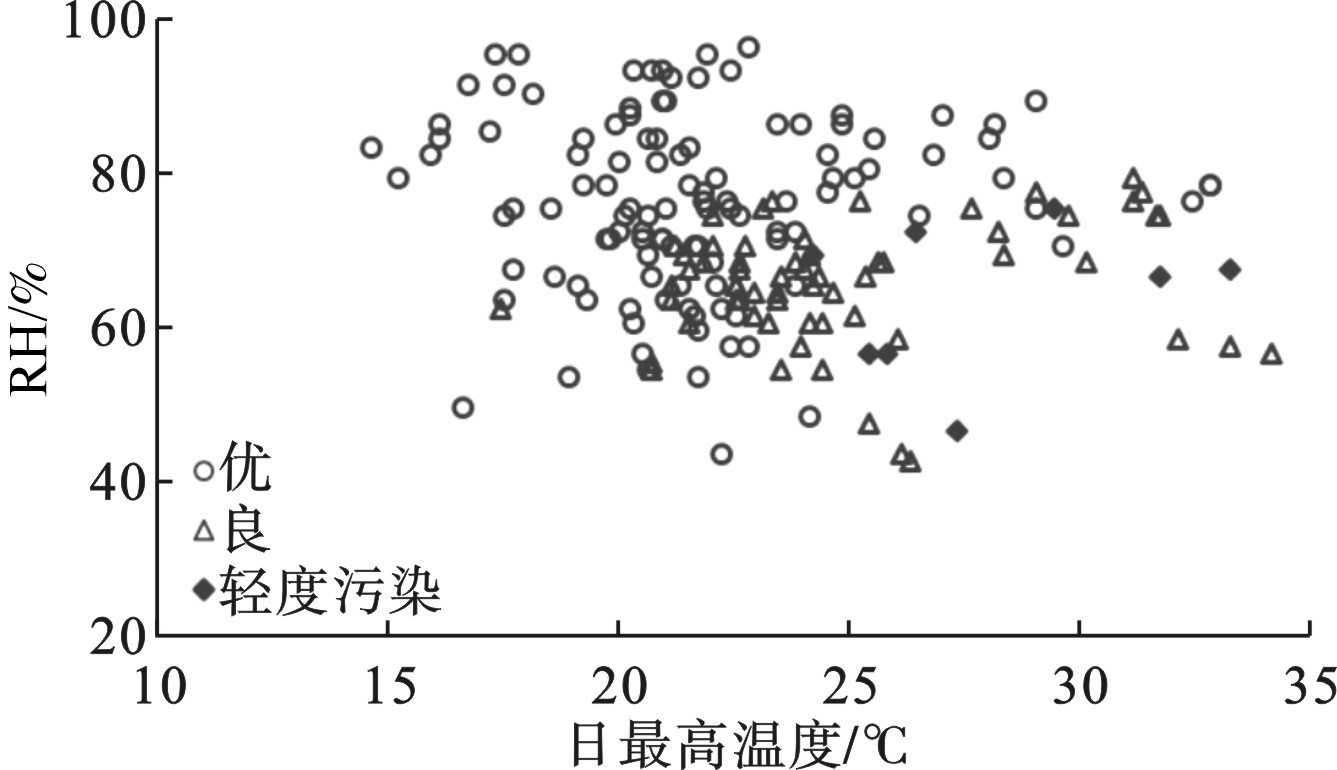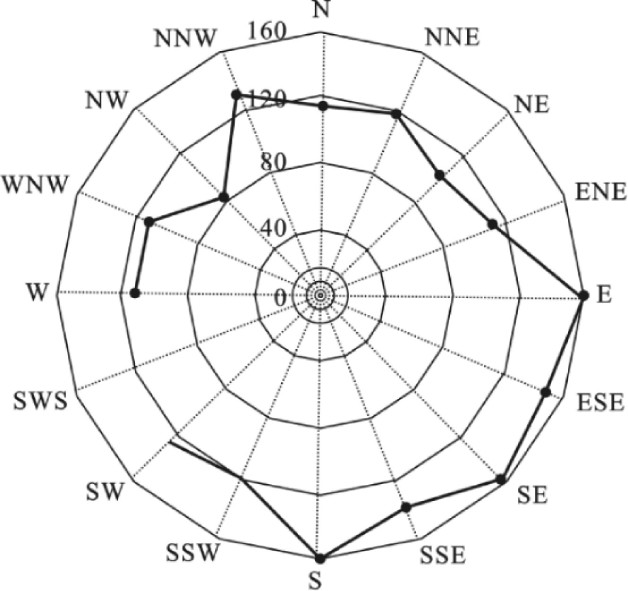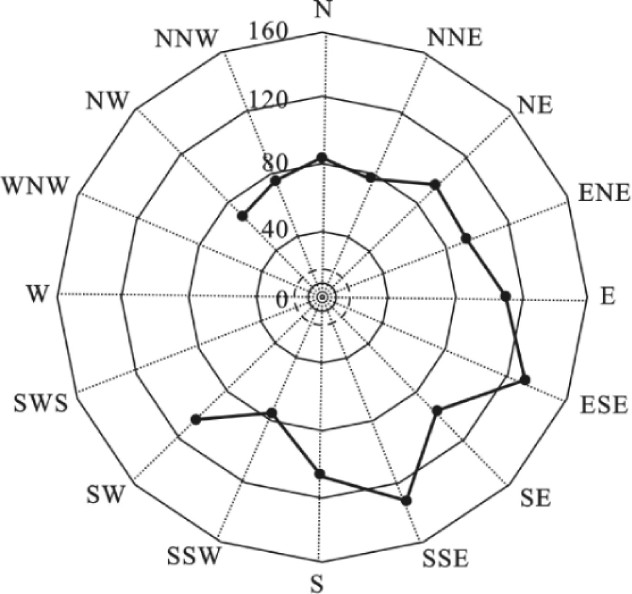-
随着城市的发展,城市中光化学污染日趋严重,臭氧已成为近年来人们非常关注的影响空气质量的污染物之一。研究表明,地面臭氧浓度的增高,将对人类的身体健康带来损害[1],尤其对呼吸系统影响严重[2],甚至会提高死亡率[3]。过去几十年里,臭氧浓度在我国大部分地区都呈现快速上升趋势[4],尤其在我国部分经济较为发达、人口密集的地区,如京津冀、长三角和珠三角等地,光化学污染日趋严重[5-8]。作为长三角主要城市之一,杭州市机动车保有量、煤炭消耗量和工业产量不断增加,但杭州市三面环山地形条件,使得大气扩散条件弱于开阔平原地区及沿海地区,污染物极易聚集[9],杭州也因此面临较为严重的臭氧污染问题[10-11]。尤其在夏秋季节,杭州以晴好天气为主,气温高、大气层结稳定,臭氧问题更加凸显[12-14]。
2023年9和10月,杭州市将举办第十九届亚运会及亚残运会。而9和10月也是杭州市臭氧污染发生较多的月份。为了做好亚运会及亚残运会期间的大气环境保障,更好应对臭氧污染问题,本研究利用2016~2021年杭州市空气质量数据,并结合天气条件分析亚运会及亚残运会同期臭氧的变化特点,以期为客观认识臭氧浓度变化特征及提前制定有效的减排及管控策略提供一定的科学依据。
-
杭州市主城区内共有环境空气质量国控监测点位10个,分别为和睦小学、朝晖五区、浙江农大、卧龙桥、下沙、云栖、城厢镇、临平镇、滨江和西溪,取平均值作为杭州市空气质量评判指标。其中朝晖五区自2021年起不再作为国控站点。监测指标主要有:二氧化硫(SO2)、二氧化氮(NO2)、可吸入颗粒物(PM10)、臭氧(O3)、一氧化碳(CO)、细颗粒物(PM2.5)和气象参数等,各点位均已具备《环境空气质量标准:GB 3095—2012)》中所要求的监测能力。
-
常规6项污染物主要采用Thermofisher公司生产的相关仪器,具体为:PM2.5和PMl0采用美国Thermofisher公司的TE5030颗粒物同步混合监测仪监测;CO采用美国Thermofisher公司TE48i CO分析仪监测;S02采用美国Thermofisher公司的TE43i SO2分析仪监测;O3采用美国Thermofisher公司的TE49i O3分析仪监测;NO2采用美国Thermofisher公司的TE42i化学发光仪监测。连续24 h在线监测,每5 min读取一次数据。在观测过程中严格按照国家环境保护部《环境空气质量自动监测技术规范:HJ/T 193—2005》利用配套校准系统对仪器进行定期标定和校准,校准时准确度审核结果表明,各点准确度在0.999 93~0.999 98。浙江省质量监督研究院每年定期对仪器进行年审和标准气体的溯源。地面气象数据来自杭州市气象局,监测设备为美国Metone公司的Metone自动气象站。
-
2016~2021年杭州市9和10月的臭氧最大8小时滑动平均浓度第90百分位数(以下简称O3-8h-90per),可以发现9月O3-8h-90per居高不下,均明显高于国家二级标准极限值,且有逐年增长的趋势。10月O3-8h-90per低于9月,基本都低于国家二级标准极限值。可见杭州市9月O3污染问题较为严重,见图1。
杭州市9和10月臭氧超标天数,其中9月臭氧超标天较多,超标概率为30%~50%。10月情况相对较好,超标天数均在5 d以内,见图2。
因此,杭州市9月臭氧浓度水平较高,臭氧超标天数较多,臭氧已成为影响杭州市9月份空气质量的关键污染物。臭氧污染防控也是杭州市2022年亚运会及亚残运会空气质量保障的关键。
-
2016~2021年杭州9和10月臭氧浓度小时变化曲线,见图3、4。
杭州市臭氧浓度日变化呈现典型“单峰型”。由于夜间NO2通过大气化学反应对臭氧的滴定作用,在早上6:00左右出现臭氧最低值。8:00以后,光化学反应作用增强,臭氧浓度开始呈现阶梯式上升,约在14:00左右达到高峰,随后臭氧浓度开始下降,直至第二天早晨。从近5年臭氧日变化数据结果来看,9月臭氧小时浓度是2019年最高,其次为2021年。10月臭氧小时浓度为2018年最高,其次为2019和2020年。
-
2016~2021年各国控站点9、10月臭氧浓度情况(朝晖五区2021年不再作为国控站点,因此2021年该站点无数据)见图5、6。
9月10个国控站点O3-8h-90per均处于高值水平,10月各站点浓度水平均低于9月。其中,9月各站点的O3-8h-90per均呈现上升趋势,尤其是卧龙桥、云栖和和睦小学,在5年间O3-8h-90per上升比例分别为43.6%、21.8%和22.0%。10月各站点浓度年际变化基本稳定,部分站点略有下降趋势。
-
基于杭州市2016~2021年气象数据,可以分析不同气象因素与臭氧浓度之间的关系。温度作为反映太阳紫外线辐射强弱的关键指标,与臭氧浓度高低存在显著相关性。日最高温度高,太阳辐射强,加快光化学反应速率,导致臭氧浓度升高[15-16]。2016~2021年9、10月不同日最高温度范围对应的臭氧最大8小时滑动平均(以下简称O3-8h)浓度均值及超标率,可见O3-8h浓度和超标天比例随温度升高而不断上升,见图7、8。
图7可知,9月,当日最高温度在25 ℃以下时,无臭氧超标情况;而当日最高温度达到30 ℃以上时,臭氧超标率显著升高,达到52.3%。图8可知,10月,当日最高温度在20 ℃以下时,极少出现臭氧超标;日最高温度﹥20 ℃时,超标率升至20%左右。
-
相对湿度作为评价大气中水汽含量的指标,是指绝对湿度与最高湿度之间的比,表明水蒸气的饱和度。在高相对湿度条件下,水汽中所含的自由基会将臭氧分解为氧分子,降低臭氧浓度,因此臭氧浓度和相对湿度呈现显著负相关[17]。2016~2021年9、10月不同湿度范围对应的O3-8h浓度均值及超标率,可见O3-8h浓度均值及超标率随湿度增加而不断下降。当相对湿度高于80%时,9、10月均不会出现臭氧超标。而当湿度<80%时,臭氧超标天数比例随着相对湿度降低而不断增加,见图9、10。
综合分析日最高温度、湿度和臭氧浓度之间的相关性,可以得到2016~2021年9、10月温度、湿度和臭氧污染等级的散点,见图11、12。
图11、12可知,在相对湿度低于80%、日最高气温高于25 ℃的天气条件下,太阳辐射强,导致光化学反应强烈,因此臭氧浓度超标的现象更容易发生,高温低湿是导致臭氧超标的主要气象因素。
-
风速风向影响臭氧的机制较为复杂。大气低层风速影响污染气体的传输及扩散过程,主要是对污染气体的平流输送,通常风速越大越有利于空气中污染气体的稀释扩散[18]。安俊琳[19]分析了气象条件对北京臭氧浓度的影响,发现臭氧浓度随风速增加而增大,主要因为较高的风速抬高了大气边界层高度,上层臭氧向地面处混合,同时较大风速的水平扩散作用又对臭氧浓度进行稀释。
2016~2021年杭州市臭氧浓度与当天平均风力等级关系,见图13、14。
图13、14可知,当风力等级为3级及以上时,臭氧浓度相对于风力较小(0~2级)时有显著下降,且不再出现超标天。
除风速之外,风向也是影响污染物传输扩散的重要因素之一[20]。根据杭州市2016~2021年9、10月每日主要风向数据,分析O3-8h浓度与风向变化的关系,见图15、16。
杭州市9月臭氧浓度高值出现在偏南风、偏东风条件下,10月臭氧浓度高值出现在东南风条件下(近5年中9月无西南偏西风向出现,10月无西南偏西、西和西北偏西风向出现)。臭氧浓度和超标率的方位分布主要是由杭州市区的天气特点和工业分布特点决定的。从天气特点来看,出现偏南风时天气多为晴朗天气,天气条件较为稳定,太阳辐射较强,大气光化学反应活跃,有利于臭氧的生成和积聚;从城市的工业布局看,在杭州主城区的东南部和南部有钱塘区、萧山区的化工企业,东部上游地区还有绍兴、宁波等地的大量工业园区及工业企业,排放的臭氧前体物(氮氧化物及VOCs)浓度大、种类多,因此在偏东风、偏南风时杭州容易出现高浓度臭氧,超标概率较大。
-
(1)杭州市9月臭氧浓度高且有逐年增长趋势,臭氧超标天数多。10月臭氧污染情况略好于9月,但也有轻度污染情况出现。因此,臭氧污染防控是2023年亚运会和亚残运会空气质量保障的关键。
(2)从气象条件看,高温和低湿是导致臭氧超标的主要气象因素。在相对湿度低于80%,日最高温度高于25 ℃时,臭氧浓度高,易出现超标天。当相对湿度高于80%,日最高温度低于25 ℃时,极少出现臭氧污染。
(3)风速与臭氧浓度呈现负相关性,当日平均风力等级高于2级时,无臭氧污染情况。总体而言,9、10月间偏东风、偏南风时,杭州臭氧浓度较高。
(4)根据近五年情况预计,2023年9月,杭州将出现10天左右臭氧超标天;10月,将出现3天左右臭氧超标天。在亚运会及亚残运会期间,出现易产生臭氧污染的不利天气条件时,应当提前研判,落实减排和管控措施。在气温较高、湿度较低时,可以在市区内采取多次洒水或利用雾炮车等方法,增加空气湿度,在条件合适时提前采取人工增雨作业;在风速较低、风向不利时,提前管控上游工业园区和企业,减少臭氧前体物(氮氧化物和VOCs)排放,从而降低臭氧污染浓度,提升空气质量。
杭州市亚运会、亚残运会同期臭氧污染及气象特征研究
Study on characteristics of ozone pollution and meteorology in Hangzhou during same period of Asian Games and Asian Para Games
-
摘要: 利用2016~2021年9和10月杭州市环境空气质量国控监测站点臭氧监测资料,分析2023年亚运会及亚残运会同期杭州市臭氧浓度变化特征,并结合气象资料分析不同气象因素与臭氧浓度之间的关系。结果表明,2016~2021年间,杭州市9和10月臭氧日最大8小时滑动平均第90百分位数最高已达到208和160 μg/m³,臭氧污染严重,臭氧超标天数多;高温、低湿是导致臭氧污染的重要天气因素,当日最高温度高于28 ℃、湿度低于80%时,极易产生臭氧污染天;低风速以及偏东风、偏南风条件下也较容易产生臭氧污染。根据近5年情况预计,2023年9月,杭州将出现10 d左右臭氧污染天;10月,将出现3 d左右臭氧污染天。在出现气温较高、湿度较低、风速较低的天气情况时,应当提前落实减排和管控措施,从而降低臭氧污染浓度,提升空气质量。Abstract: Based on the ozone data monitored by Hangzhou state-controlled ambient air quality monitoring sites in September and October from 2016 to 2021, this study analyzed the characteristics of the surface ozone concentration during the same period of the Asian Games and the Asian Para Games in Hangzhou, 2023. Furthermore, the relationship between meteorological conditions and the ozone concentration was also studied. The results showed that the highest 90th percentile of O3-8 h in Hangzhou could reach 208 and 160 μg/m³ in September and October for the past 5 years, thus indicating a severe ozone pollution and excessive number of days. Higher temperature and lower relative humidity were the most important factors related to the ozone pollution. The ozone concentration was in an excessive condition when the daily highest temperature was up to 28℃ and relative humidity was lower than 80%. Moreover, a low wind speed and an easterly wind or a southerly wind could also cause the ozone pollution. According to the situation in the past five years, there would be about 10 days for the ozone pollution in September and about 3 days for the ozone pollution in October in 2023. Therefore, the emission reduction and control measures should be implemented to reduce the ozone pollution concentration and improve the air quality with the weather condition of a higher temperature, a low humidity and a low wind speed.
-

-
[1] NORVAL M, LUCAS R M, CULLEN A P, et al. The human health effects of ozone depletion and interactions with climate change[J]. Photochemical & Photobiological Sciences, 2011, 10(2): 1 − 28. [2] ZWICK H, POPP W, WAGNER C, et al. Effects of ozone on the respiratory health, allergic sensitization, and cellular immune system in children.[J]. The American Review of Respiratory Disease, 1991, 144(5): 1075 − 1079. doi: 10.1164/ajrccm/144.5.1075 [3] GRYPARIS A, FORSBERG B, KATSOUYANNI K, et al. Acute effects of ozone on mortality from the air pollution and health[J]. American Journal of Respiratory & Critical Care Medicine, 2004, 170(10): 1080 − 1087. [4] XU X, LIN W, WANG T, et al. Long-term trend of surface ozone at a regional background station in eastern China 1991–2006: enhanced variability[J]. Atmospheric Chemistry and Physics, 2008, 8(10): 2595 − 2607. doi: 10.5194/acp-8-2595-2008 [5] 程麟钧, 王帅, 宫正宇, 等. 中国臭氧浓度的时空变化特征及分区[J]. 中国环境科学, 2017, 37(11): 4003 − 4012. doi: 10.3969/j.issn.1000-6923.2017.11.001 [6] 余益军, 孟晓艳, 王振, 等. 京津冀地区城市臭氧污染趋势及原因探讨[J]. 环境科学, 2020, 41(1): 106 − 114. [7] 单源源, 李莉, 刘琼, 等. 长三角地区典型城市臭氧及其前体物时空分布特征[J]. 沙漠与绿洲气象, 2016, 10(5): 72 − 78. doi: 10.3969/j.issn.1002-0799.2016.05.011 [8] 张莹, 岳玎利, 江明, 等. 珠江三角洲臭氧污染特征与趋势初步分析[J]. 广东化工, 2016, 43(12): 152 − 153. doi: 10.3969/j.issn.1007-1865.2016.12.074 [9] 齐冰, 刘寿东, 杜荣光, 等. 杭州地区气候环境要素对霾天气影响特征分析[J]. 气象, 2012, 38(10): 1225 − 1231. doi: 10.7519/j.issn.1000-0526.2012.10.008 [10] 陈超, 严仁嫦, 叶辉, 等. 杭州市臭氧污染特征研究[J]. 环境污染与防治, 2019, 41(3): 339 − 342. doi: 10.15985/j.cnki.1001-3865.2019.03.017 [11] 齐冰, 牛或文, 杜荣光, 等. 杭州市近地面大气臭氧浓度变化特征分析[J]. 中国环境科学, 2017, 37(2): 443 − 451. [12] 严仁嫦, 叶辉, 林旭, 等. 杭州市臭氧污染特征及影响因素分析[J]. 环境科学学报, 2018, 38(3): 1128 − 1136. doi: 10.13671/j.hjkxxb.2017.0430 [13] 严宇, 田旭东, 王雪松, 等. 杭州市夏季臭氧污染的气象与传输特征分析[J]. 环境污染与防治, 2021, 43(2): 182 − 187. [14] 洪盛茂, 焦荔, 何曦, 等. 杭州市区大气臭氧浓度变化及气象要素影响[J]. 应用气象学报, 2009, 20(5): 602 − 611. doi: 10.3969/j.issn.1001-7313.2009.05.012 [15] HESS G D, CARNOVALE F, COPE M E, et al. The evaluation of some photochemical smog reaction mechanisms—I. Temperature and initial composition effects[J]. Atmospheric Environment, 1992, 26(4): 625 − 641. doi: 10.1016/0960-1686(92)90174-J [16] BELAN B D, SAVKIN D, TOLMACHEV G. The relationship between ozone formation and air temperature in the atmospheric surface layer[C]//Egu General Assembly Conference. EGU General Assembly Conference Abstracts, 2016. [17] 石志平, 王文生. 相对湿度变化对臭氧分解速率的影响[J]. 保鲜与加工, 2004, 4(6): 24 − 25. doi: 10.3969/j.issn.1009-6221.2004.06.012 [18] 栗泽苑, 杨雷峰, 华道柱, 等. 2013—2018年中国近地面臭氧浓度空间分布特征及其与气象因子关系的研究[J]. 环境科学研究, 2021, 34(9): 2094 − 2104. [19] 安俊琳. 北京大气臭氧浓度变化特征及其形成机制研究[D]. 南京: 南京信息工程大学, 2007. [20] 韩明山, 梅宁, 陈丽飞. 风向变化对城市大气污染的影响及试验分析[J]. 能源环境保护, 2004, 18(5): 56 − 59. doi: 10.3969/j.issn.1006-8759.2004.05.018 -



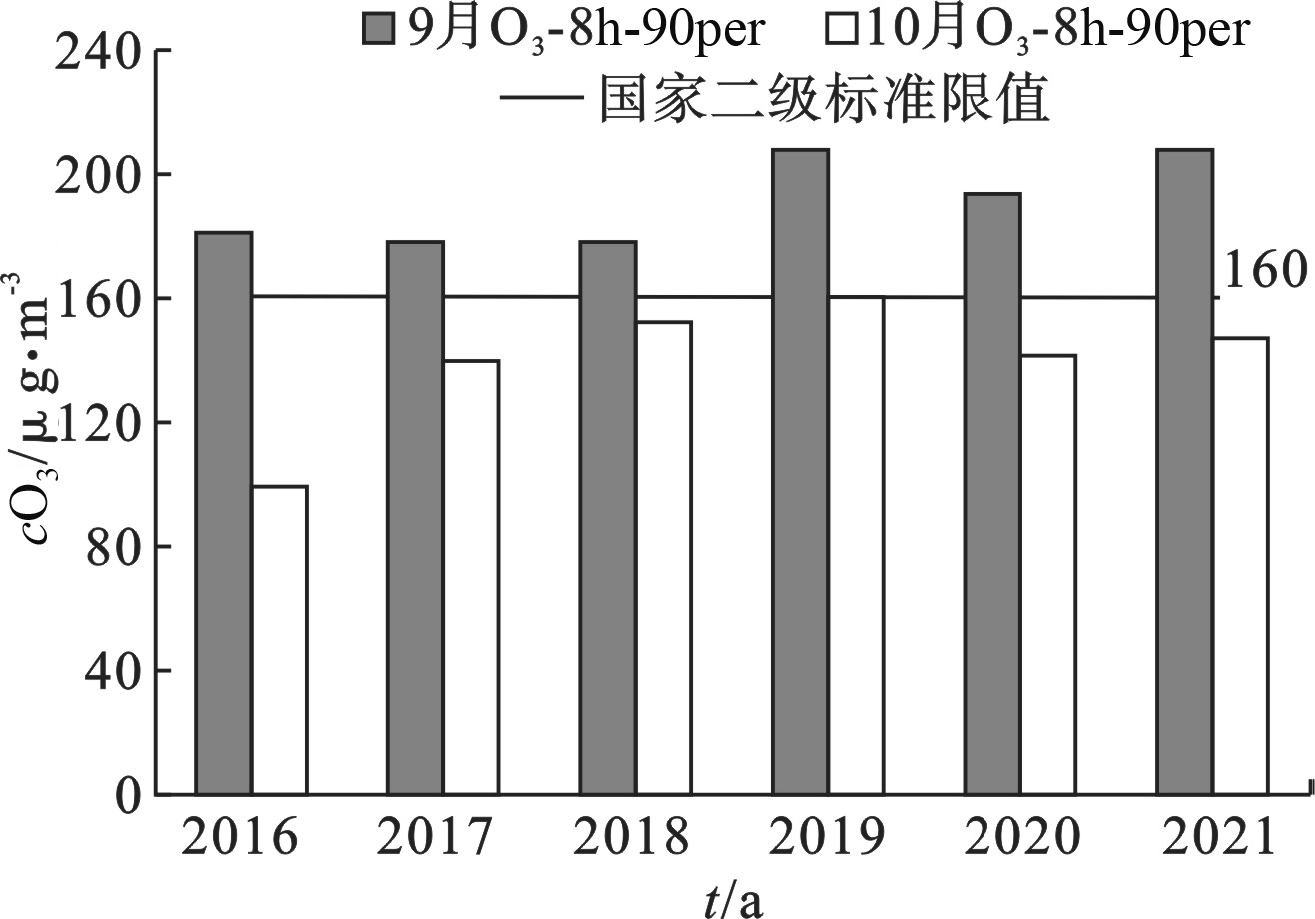
 下载:
下载:
